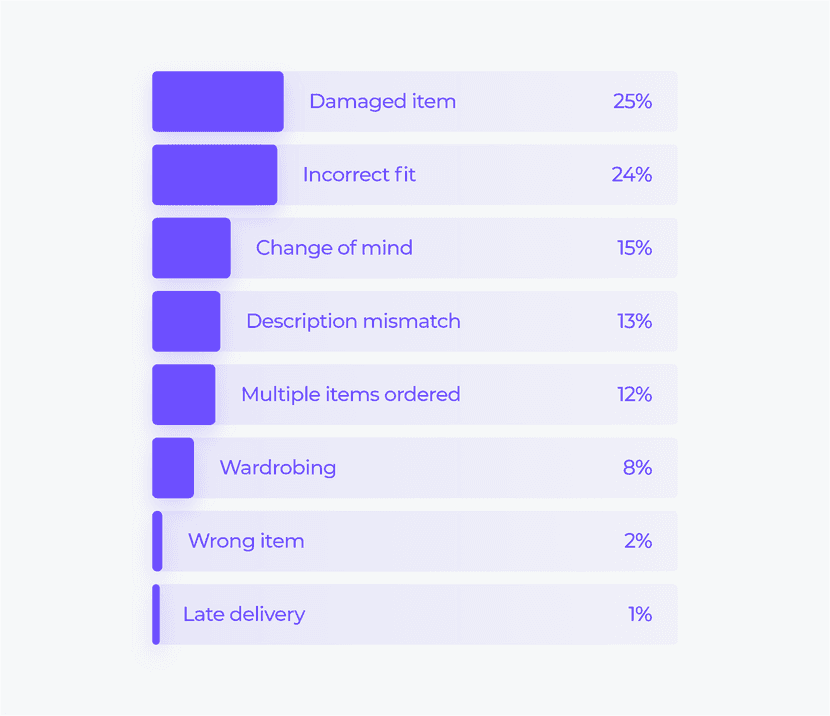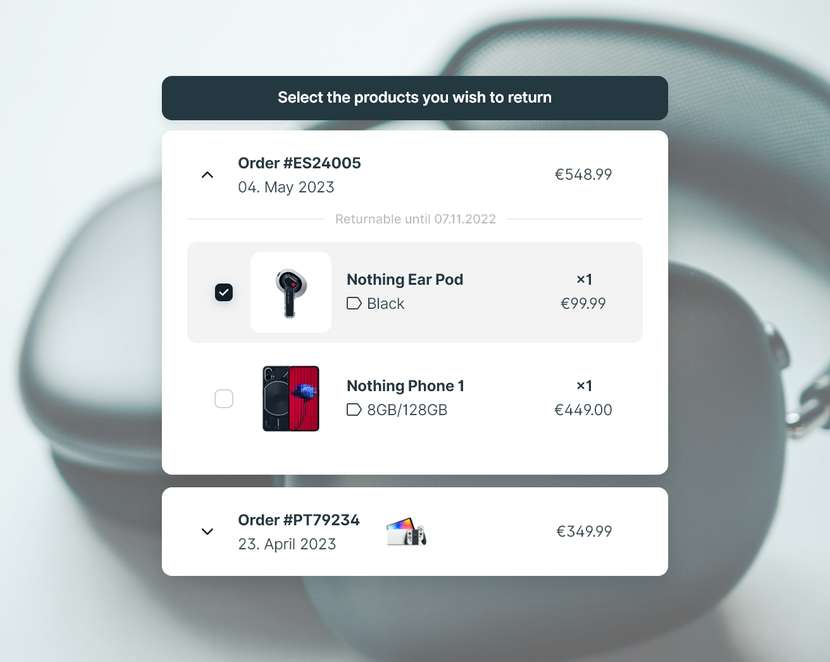Returns stand out as one of the most financially impactful challenges for eCommerce businesses and online stores. According to insights from the National Retail Federation, in 2022 the annual cost linked to returns in the U.S. surpasses a notable $816 billion in lost sales. This substantial amount reflects the total value of merchandise returned by customers and left unsold.
In essence, U.S. retailers faced a loss of $816 billion in potential revenue due to returned products. Out of the 1,3 trillion U.S. dollars in online sales recorded in 2022, approximately 16,5% resulted in returns. This sheds light on the intricate dynamics of the eCommerce process, where convenience meets the unavoidable reality of returns.
According to data provided by InvespCRO, approximately 30% of all online-ordered products are returned to the original businesses. In contrast, Outvio's data suggests a slightly lower average of around 20%. Nevertheless, this figure remains noteworthy and warrants further exploration. Moreover, according to the same research, InvespCRO discovered that 92% of consumers are likely to revisit an eCommerce store after a positive return experience.
Collectively, these insights underscore that while returns pose a massive problem for eCommerce, they simultaneously open doors to new opportunities for businesses willing to address and optimize this aspect of their operations through the use of return management software for eCommerce.
What is returns management in eCommerce?

Returns management is a method for organizing and processing product returns in the retail business. Although each online store may have its unique processes and rules for handling customer returns more efficiently, the fundamental process remains consistent. The primary objective is to transport products back to the online store in the easiest and most cost-effective way, providing customers with refunds and support throughout this process. However, not all online stores handle these processes well, and some stores even lack a clear returns process. All of these factors can impact overall business growth and potentially decrease the profitability of e-commerce.
Benefits of well-organized returns management
Improved customer satisfaction and loyalty: Efficient returns management quickly resolves issues, generating a seamless customer experience and strengthening relationships, which incentivizes repeat purchases.
Cost reduction: Optimizing internal processes related to returns not only improves efficiency but also proactively addresses recurring problems, resulting in a significant reduction in associated and logistical costs.
Inventory optimization: Proper management facilitates accurate inventory monitoring, identifying defective or expired products early on to efficiently manage stock and ensure the quality of available products.
Relevant data extraction: Collecting and analyzing data on returns provides valuable information for making informed decisions, identifying patterns and trends, and thus improving product and service quality.
Regulatory compliance: Efficient management ensures compliance with local regulations, protecting the company from legal problems and strengthening its ethical and legal position in the market.
Competitive differentiation: Implementing a strong policy can significantly differentiate the company, highlighting it in a competitive market and attracting consumers with a superior experience.
Sustained revenue growth: To maximize the returns yield, strategies such as offering related products or special promotions turn returns into new sales opportunities, contributing to revenue growth.
eCommerce Returns Management Challenges

The exponential growth of online sales has led to a significant increase in product returns in eCommerce. This phenomenon has forever changed the consumption habits of a large part of the population. It also has brought a list of whole new challenges that retailers have to navigate.
The additional cost of returns
For online stores, managing returns poses a significant challenge involving numerous costly processes, including processing, reverse shipping, customer service, and reconditioning. When factoring in advertising and promotional discounts common in many online stores, it becomes a substantial list of outcomes that can strain your budgets.
Moreover, customer dissatisfaction comes into play if returns are inconvenient. Customers are likely to leave your online store in favor of one with streamlined return processes and additional perks.
As an online seller, it is crucial to implement measures for efficient returns processing or to reduce their frequency. Failure to do so may result in the accumulation of costs and customer churn, posing a serious threat to your profitability.
Precision in tracking returns
Tracking e-commerce returns becomes particularly challenging, especially for large online stores that handle over 10 000 shipments a month. Implementing a seamless tracking system is crucial for transparency and process optimization in e-commerce. Additionally, tracking returned products is valuable for customers, providing them with a sense of security and assurance that their return is not lost and is being processed properly.
Return fraud
Dealing with fraudulent returns adds an extra layer of challenge for eCommerce businesses. In 2023, return fraud inflicted substantial financial losses on retailers, reaching a staggering $101 billion. To put it in perspective, for every $100 worth of returned merchandise, retailers are experiencing a significant loss of $13.70 due to return fraud. This underscores the economic impact and challenges posed by fraudulent return activities within the retail sector.

Here are some brief pieces of advice that can help prevent return fraud:
1. Update your return policy
Clearly specify conditions, timeframes, and shipping instructions to prevent fraudulent activities. Be explicit about exceptions for personalized items to avoid any confusion.
2. Use smart technology
Track orders and returns to prevent false claims. Offer partial refunds and employ fraud detection tools. Analyze return reasons and check personal return rates using return management software.
3. Fight fraudulent returns
Implement a chargeback recovery system to dispute claims and recover lost revenue, adapting to each situation.
Blacklist individuals, a practice adopted even by major brands. Prioritize legitimate customers, distancing from those aiming to harm your business for personal gain.
Inspect items before processing refunds to prevent issues like "bricking". Ensure compliance with return policy requirements and discourage such behavior.
Explore our detailed article on fraudulent returns. Learn effective strategies to detect and prevent various forms of return fraud, ensuring the security of your online store.
Related article
8 Key Factors of eCommerce Returns Management

1. Return rate
The return rate is a key metric that measures the percentage of products returned by customers. Beyond reflecting the frequency of returns in your online store, it provides valuable insights for enhancing specific aspects of eCommerce strategy.
The return rate serves as a valuable indicator not only of customer satisfaction but also of whether their expectations were met. It provides insights into potential areas for improvement in product descriptions, website content, and even advertising strategies.
Return Rate = (Returned Orders / Total Orders) * 100
In cases where there are noticeable spikes in the return rate for specific products or product groups, it is advisable to assess your current advertising practices. This could involve ensuring that your ads contain sufficient information about the product and that the images used are accurate, avoiding any potential misrepresentation (such as displaying outdated product versions or showcasing unavailable colors).
It's common for advertisements to emphasize a product's positive aspects, but it's essential to maintain transparency. While monitoring the return rate is crucial, it's important not to overanalyze it. Returns are a natural aspect of eCommerce, especially when they occur at a consistent rate.
According to a study by Shopify, the average return rate in eCommerce is around 20%. However, this percentage can vary by industry and product type. For instance, the fashion industry usually has a return rate of about 26% or even more, while the sports and outdoor goods industry maintains a lower rate of 7%.
2. Return reasons
Analyzing return reasons is a valuable practice in eCommerce, shedding light on the factors driving customers to return products. This data proves insightful for refining your product distribution strategies. Identifying products with recurring returns due to poor quality is essential. While online stores can't alter a product's quality, it might be prudent to consider removing such items from your website, as frequent returns can render those sales unprofitable.
Additionally, understanding specific reasons for returns, such as oversized apparel items, allows for strategic categorization adjustments. For instance, if a particular clothing item, like a t-shirt, is frequently returned due to size issues, categorizing it under an "oversized" section on your website can manage customer expectations and reduce return rates for that specific product.
Effectively managing eCommerce involves a key step - comprehending the reasons behind returns. Delving into the causes not only reveals the driving factors behind returns but also facilitates strategic decisions aligned with resolving genuine buyer concerns, ultimately enhancing overall effectiveness.
Some of the most common return reasons in eCommerce are:
- Damaged or broken item: The customer received the product in a condition that is damaged, broken, or has a quality issue, rendering it unusable.
- Wrong size: The item does not fit the customer as expected, either too big or too small.
- Change of mind or buyer's remorse: The customer decided they don't want or need the product after receiving it.
- Description mismatch: The product is not as described in the product listing or customer expectations.
- Multiple items ordered for return: The customer ordered multiple items or sizes with the intention of returning some of them.
- Wardrobing: The customer intentionally returned an item after a single use, often for a refund or store credit.
- Wrong item delivered: The customer received the wrong item, either a different product or a different size.
- Order arrived too late: The order arrived after the estimated delivery date, causing inconvenience or dissatisfaction for the customer.

3. Return policy
The return policy is a digital document that establishes the terms and conditions under which customers can return a product. It is a fundamental tool in protecting the rights of both the consumer and retailer, and ensuring a positive shopping experience.
The return policy should be clear, transparent, and easy to understand for customers. It should address at least the following aspects:
- Which products are eligible for return: Typically, online store purchases can be returned as long as they are in good condition and still in their original packaging. However, it's essential to note that there are exceptions, including custom-made or perishable goods.
- What is the return period: The return period refers to the timeframe within which a customer can return a product without incurring any penalties. In the United States, this period is typically 30 calendar days from the date of product receipt, while in Europe, the legal minimum return period is 14 days.
- Who pays for return shipping: Return shipping costs are usually borne by the customer, unless the product is defective or does not match the order. However, many prominent online retailers, such as Amazon, Zalando, ASOS, Bestsecret, go the extra mile by absorbing the costs associated with returns.
- How to process the return: Customers should be aware of the necessary steps to facilitate a product return. Implementing automated self-service returns portals simplifies the process for the end customer, providing added convenience and earning extra points for the online store.
4. Return requests
Return requests, also known as merchandise return authorizations (RMA), play a crucial role in enabling sellers to identify and efficiently handle product returns. These requests typically contain customer details, information about the item to be returned, the reason behind the return, and shipping instructions. Upon approval, sellers can monitor the return process and take appropriate actions, such as issuing a refund or providing a replacement.
In the realm of eCommerce, two options exist for submitting return requests. The first involves customers manually reaching out to your support department, though this method is not recommended due to potential delays and request backlogs, which can significantly impact the customer experience.
The preferred alternative is a digital returns portal seamlessly integrated into your online store. This approach empowers customers to manage their return requests autonomously, promoting efficiency and ensuring a swift and effective response to their needs.
Implementing a smart rules system allows you to tailor unique workflows for each return request, ensuring a customized process for every product. A well-designed return management workflow, supported by robust RMA software, stands out as one of the most effective and widely adopted strategies for boosting margins and profitability.
5. Reverse logistics
To get the returned product back to the original warehouse, you will need to schedule a reverse shipment with a transportation company. Many carriers offer this service, so you should find and hire the services of the one that best meets your needs.
The primary pickup options for effective return logistics include:
- Drop-off at a pickup point
- Pickup at the customer's home
- Drop-off at a physical store
Drop-off at a pickup point is often the most cost-effective and straightforward to manage. Moreover, buyers frequently find it more convenient as they can return the product at their preferred time, whether it's during their commute, on the way home, or over the weekend.
While home pickup may seem convenient, it often comes with a higher cost and the potential challenge that the buyer may not be available at the scheduled time.
Drop-off at a physical store can be advantageous only if the store has a local presence. Otherwise, it may not be the most optimal method for product returns.
To efficiently handle these diverse possibilities, opting for reverse logistics software that supports pickup point drop-offs is highly recommended.
Related article
💻 Return API integration
When handling automated returns in a store, speed becomes a critical factor. Seamless communication with carrier companies is essential for the efficient functioning of returns.
There are two approaches how to integrate carriers in online stores:
- Directly integrating each carrier with the store's returns manager. This is the most expensive option, as it requires a development team, optimal infrastructure, and constant maintenance.
- Connecting an external software that comes equipped with integrated carriers, which tends to be the go-to solution for numerous retailers and global eCommerce businesses. Another noteworthy benefit is that these software often provide a
- Return API, allowing you to expedite the return initiation process and promptly assign a courier in real-time.
6. Return tracking
Return tracking is the process of monitoring and tracking the movement of a returned package from the point of return to its final destination.
Each package is assigned a unique tracking number that makes it easy to identify and allows sellers to send automatic notifications with the latest statuses and locations of the ongoing return.
This provides several benefits, including:
- Visibility and transparency in the logistics process. You will be able to see where returned packages are at all times and take action whenever you need to
- Contribution to the customer experience. Buyers expect brands to keep them updated on the status of their purchases. Providing them with this information is essential for their satisfaction
- Preventing losses. Return tracking helps businesses identify and address any problems or delays in the returns process
Avoid sending your customers to carrier tracking pages
While many carriers offer tracking information through links or portals for both merchants and customers, a notable limitation is the inability to personalize them with your own designs and branding. We view this as a missed opportunity for marketing and communication. Additionally, these portals lack user-friendliness, and the messages sent by carriers are often unclear and impersonal.
Opting for advanced return management software enables you to craft personalized notifications that align with your corporate style. You can use notification as an additional tool for up-selling the products, and create campaigns to incorporate product recommendations tailored to your customer's preferences or past purchases. This transforms each notification into a fresh opportunity to generate additional revenue.
Related article
7. The return label
The return label is a document that contains the transportation information necessary to get the returned product back to the original warehouse. It includes details such as the sender's address, the return address, order information, the RMA number, and the tracking number.
There are two main types of return labels:
- Prepaid: These are pre-printed labels included in the original package, ready to use in case the customer wants to return a product
- Digital: The label is sent to the customer's email only once requested. It can be created manually or through return management software.
Some online stores specializing in apparel and sports equipment include a return label in every package they send, streamlining the return process for customers. This thoughtful approach eliminates the need for customers to print labels themselves, allowing them to initiate returns promptly on the same day in case of any issues with the received item.
8. Refunds
Once a return has been accepted or the product has arrived at the warehouse, you will need to process the refund. The type of refund will depend on the payment method used by the customer and your return policy.
The most common refund methods are:
- Bank transfer
- Credit card
- Store credit
Streamlining product exchanges and providing store credit in lieu of refunds presents a strategic approach to retain sales, demonstrating a proactive revenue retention practice. Encouraging these alternatives proves to be an effective strategy in maintaining revenue for eCommerce business.
How to reduce returns in eCommerce

Returns are a costly reality for online retailers. The logistics, transportation, potential product depreciation, refund payments, and administrative burdens can erode your profit margin if you don't take steps to minimize them.
Reducing returns has become a top priority for eCommerce businesses. By implementing effective return reduction strategies, you can not only save money but also improve customer satisfaction and loyalty.
Here are some of the tactics that help reduce returns in eCommerce:
- Using accurate product images and descriptions: Provide detailed and high-quality images from multiple angles, and write comprehensive descriptions that accurately depict the product's features, size, and fit. This will help customers make informed decisions and reduce the likelihood of returns due to product mismatches.
- Offering exceptional customer service: Respond promptly and helpfully to customer inquiries, address any concerns they may have about a product, and offer solutions before they resort to returning the item. A positive customer experience can prevent returns and foster long-term loyalty.
- Deploying revenue retention techniques: Instead of immediate refunds, consider offering store credit or product exchanges for higher-value items. This encourages customers to retain their purchase and potentially make additional purchases, generating further revenue rather than just issuing refunds.
- Utilizing feedback data: Incorporate user feedback on returned products to enhance the product descriptions on your website. Analyze the primary reasons for returns and supplement the relevant product pages with additional information.
By incorporating these strategies, you can significantly decrease returns, cut operational costs, and alleviate the workload on customer support. For more detailed insights, refer to our comprehensive article on the matter linked below.
Related article
Converting returns into revenue

Transforming returns into revenue has emerged as a pivotal trend in eCommerce. To achieve this, implementing strategies that promote product exchanges over direct returns is key.
Why do product exchanges contribute to revenue growth? By sustaining the business relationship with the buyer, exchanges not only prevent sales loss but also lead to new transactions and foster customer loyalty.
Here are some tips for prioritizing product exchanges:
- Offer Free Exchanges: Remove the financial barrier by providing free shipping and handling for exchanges, making the process convenient and appealing.
- Extend Exchange Timeframes: Allow customers ample time to decide by extending the exchange window, reducing the likelihood of immediate returns.
- Incentivize In-Store Credit: Encourage in-store credit by offering discounts or exclusive promotions, keeping customers engaged and boosting future purchases.
- Send Personalized Promotions: Target customers with personalized promotions for related products after an exchange, demonstrating an understanding of their preferences.
- Facilitate Automated Exchanges: Streamline the process with easy-to-follow instructions and clear communication channels. Integrate software that automates both exchange requests and their processing for a seamless customer experience.
It's crucial to choose return management software that not only automates exchange requests but also their processing. This ensures a smooth and efficient exchange process for both customers and eCommerce businesses.
eCommerce Returns Management Best Practices: The Ultimate Checklist

As an eCommerce retailer, optimizing your return process is essential. Implementing effective strategies not only enhances customer satisfaction but also minimizes the impact of returns on your business's bottom line.
We've extracted insights from a multitude of articles, providing concise descriptions for each strategy, which are listed below:
- Analyze Return Reasons Continuously: Regularly assess return reasons to identify areas for improvement.
- Design a Customer-Centric Return Policy: Foster satisfaction with extended deadlines and flexible refund options.
- Prominently Display Your Return Policy: Ensure easy accessibility on your website to avoid customer confusion.
- Personalize the Return Portal: Enhance brand recall with a branded return portal for a seamless customer experience.
- Optimize Product Information: Reduce returns by providing detailed and accurate product descriptions.
- Establish a FAQ Section: Minimize customer service inquiries by addressing common return-related questions.
- Empower Customers with Self-Management Tools: Create a portal for customers to initiate, track, and manage their return requests independently.
- Automate Return Request Resolution: Streamline processes based on customer location and refund preferences.
- Choose Efficient Shipping Carriers: Minimize shipping costs by selecting the most cost-effective carrier for each return request.
- Prioritize Packaging and Inspection: Prevent damage and ensure accurate product delivery by carefully packaging and inspecting products before shipping.
- Verify Damage Claims with Photos: Request photographic evidence for returned damaged products for fair and accurate handling.
- Encourage Product Exchanges: Reduce the financial impact of returns and encourage repurchases by offering exchange options.
- Promote In-Store Credit Refunds with Discount Coupons: Retain revenue and increase customer engagement by incentivizing in-store credit refunds.
- Provide Real-Time Return Status Notifications: Keep customers informed with timely and informative notifications about the progress of their return requests.
- Transform the Return Phase into a Marketing Opportunity: Cross-sell and increase average order value by promoting relevant and complementary products throughout the return process.
- Harness the Power of an Advanced Portal: Convert returns into sales opportunities by integrating a portal that allows customers to purchase additional products during the exchange process.
Related article
You can learn more about eCommerce returns best practices in our complete guide.
Conclusion
In conclusion, efficient eCommerce returns management is crucial for profitability and customer loyalty. The impact of returns on the industry is substantial, with costs exceeding $800 billion annually. Positive return experiences lead to a 92% likelihood of customers returning to an online store.
Challenges include the extra cost of returns, return fraud, and precise tracking. Compliance with return policy regulations, especially in the United States, is essential for legal adherence.
Key elements of the return process involve monitoring return rates, clear return policies, and streamlined return requests. Overcoming challenges, such as avoiding carrier tracking system limitations, and utilizing return labels contribute to efficient returns.
The return process extends to refunds and revenue retention. Strategies like offering store credit refunds and promoting product exchanges turn returns into revenue opportunities. Real-time return status notifications and personalized promotions enhance the overall customer experience.
As eCommerce evolves, businesses must stay informed and optimize their return processes. Implementing best practices minimizes returns' impact and transforms them into opportunities for growth and customer loyalty.
How Outvio can help you

Are you looking for ways to streamline and enhance your eCommerce returns processes? Outvio is a powerful platform designed to help you achieve this goal. With a suite of features, including an automated returns portal and seamless global carrier integration, along with shipping automation, Outvio can streamline your post-purchase operations, making them efficient, profitable, and customer-friendly.
Unleash the Power of Outvio's Key Features:
- Return Portal with Revenue Plus: Empower your customers with a user-friendly returns portal that allows them to manage the entire returns and exchanges process independently. Leverage an advanced AI system to customize each request, enabling effective marketing and loyalty strategies to retain customers and increase revenue.
- Customer Support: Streamline your support processes by using an all-in-one toolset seamlessly integrated with your eCommerce so your support team can provide an optimal customer experience without the need for extra helpdesk software.
- Carrier Integration: Seamlessly connect with major global carriers, enabling automated processing of returns and exchanges on an international scale. This eliminates manual data entry and reduces processing time, ensuring faster returns for your customers.
- HyperNotifications: Set up automated notifications for both your customers and carriers, based on predefined conditions. This proactive approach ensures timely communication, minimizing shipping delays and transportation incidents, while providing customers with real-time updates on their return status.
- Global Infrastructure: Outvio's global infrastructure ensures a seamless experience for your customers worldwide. Manage shipping, returns, order management, customer service, and extract real-time analytics for better decisions.
